Match column-I with column-II and choose the correct option.
| A. Spring wood or | I. Lighter in colour early wood |
|---|---|
| B. Autumn wood or | II. High density late wood |
| .. | III. Low density |
| .. | IV. Darker in colour |
| .. | V. Larger number of xylem elements |
| .. | VI. Vessels with wider cavity |
| .. | VII. Lesser number of xylem elements |
| .. | VIII. Vessels with small cavity |
Which of the following combination is correct ?
A II, IV, VII, VIII; B I, III, V, VI
A I, II, VII, VIII; B III, IV, V, VI
A I, III, V, VI; B II, IV, VII, VIII
A I, III, VII, VIII; B II, IV, V, VI
Correct Answer :
C. A I, III, V, VI; B II, IV, VII, VIII
Spring wood is the part of an annual ring of wood, characterized by large, thin-walled cells, formed during the first part of the growing season. It is lighter in colour with low density. It produces a larger number of xylem elements having vessels with wider cavities.
Autumn wood or late wood is the wood element formed during winter when cambial activity is more. It is darker in colour with high density.Wood elements are lesser in amount and have narrow lumen.
Related Questions
Read the following statements and answer the question.
- Cambium is very active and produces a large number of xylary elements having vessels with wider cavities.
- It is also called early wood.
- It is lighter in colour and has lower density.
Which type of wood is described by the above statements?
Sap wood
Heart wood
Spring wood
Autumn wood
In land plants, the guard cells differ from other epidermal cells in having
cytoskeleton.
mitochondria.
endoplasmic reticulum.
chloroplasts.
Which of the following statement(s) is/are not correct?
- Cork cambium is also called phellogen.
- Cork is also called phellem.
- Secondary cortex is also called periderm.
- Cork cambium, cork and secondary cortex are collectively called phelloderm.
(iii) and (iv)
(i) and (ii)
(ii) and (iii)
(ii) and (iv)
The vessel elements of angiosperms differ from other elements of xylem in having
simple pits on their radial walls.
bordered pits on their lateral walls.
simple and bordered pits on their end walls.
simple perforation on their end walls.
Identify the types of simple tissue indicated by A, B, C and D and their function.
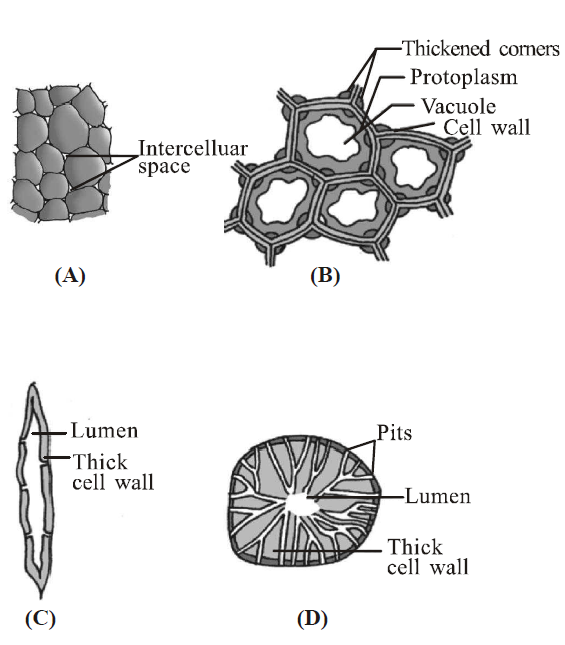
A Parenchyma, Photosynthesis, Storage and Secretion.
B Sclerenchyma Scleriods; Transport food material
C Collenchyma; Provides mechanical support to organs.
D Sclerenchyma Fibres; Provide Mechanical support to the growing parts of the plant such as young stem and petiole of a leaf.
Cork is formed from
phellogen
vascular cambium
phloem
xylem
Some vascular bundles are described as open because these
are surrounded by pericycle but not endodermis.
are capable of producing secondary xylem and phloem.
possess conjunctive tissue between xylem and phloem.
are not surrounded by pericycle.
A plant tissue when stained showed the presence of hemicellulose and pectin in cells wall of its cells. The tissue is called
collenchyma
sclerenchyma
xylem
meristem
Trees at sea do not have annual rings because
soil is sandy.
there is climatic variation.
there is no marked climatic variation.
there is enough moisture in the atmosphere.
Which of the following pair of match is not correct?
Pith - Large and well developed in monocotyledonous root.
Root hairs - Helps in preventing water loss due to transpiration
Sieve tube elements - Its functions are controlled by the nucleus of companion cells.
Stomatal apparatus - Consists of stomatal aperture, guard cells and surrounding subsidiary cells
Apical and intercalary meristems are primary meristems because
they occur in the mature region of roots and shoots of many plants.
they made up of different kinds of tissues.
they involved in secondary growth.
they appear early in life of a plant and contribute to the formation of the primary plant body.
T.S. of dicot leaf passing through the midrib is given below. Certain parts have been marked by alphabets (A to H). Choose the option showing their correct labelling.

A Epidermis, B Spongy mesophyll, C Palisade mesophyll, D Stomata, E Guard cells, F Phloem, G Metaxylem, H Protoxylem
A Epidermis, B Palisade mesophyll, C Spongy mesophyll, D Sub-stomatal cavity, E Stoma, F Phloem, G Xylem, H Bundle sheath
A Epidermis, B Palisade mesophyll, C Spongy mesophyll, D Stomata, E Guard cells, F Epidermis, G Xylem, H Phloem
A Epidermis, C Palisade mesophyll, C Spongy mesophyll, D Stomata, E Guard cells, F Phloem, G Metaxylem, H Protoxylem
A tissue is a group of cells which are
similar in origin, but dissimilar in form and function.
dissimilar in origin, form and function.
dissimilar in origin, but similar in form and function.
similar in origin, form and function.
In the given figure of phloem tissue, identify the marked part (A, B and C) which help in maintaining the pressure gradient
in the sieve tubes.
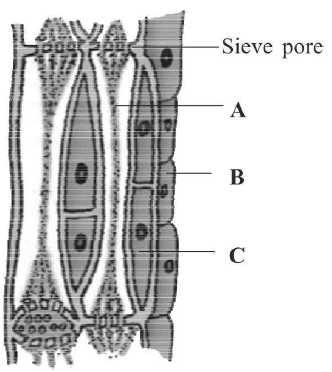
A
B
C
None of the above
T.S. of dicot stem is given below, certain parts have been marked by alphabets (A I). Choose the option which shows their correct labelling.

A Epidermis, B Epidermal hair, C Parenchyma, D Starch sheath, E Hypodermis (collenchyma), F Vascular bundle, G Bundle cap, H Medulla or pith, I Medullary rays
A Epidermal hair, B Epidermis, C Hypodermis (collenchyma), D Parenchyma, E Endoderm is (Starch Sheath), F Pericycle, G Vascular bundle, H Medullary rays, I Medulla or pith
A Epidermal hair, B Epidermis, C Hypodermis (collenchyma), D Starch sheath, E Parenchyma, F Vascular bundle, G Bundle cap, H Medulla or pith, I Medullary rays
A Epidermal hair, B Epidermis, C Parenchyma, D Hypodermis (collenchyma), E Starch sheath, F Vascular bundle, G Bundle cap, H Medulla or pith, I Medullary rays
Which of the following figure is a type of permanent tissue having many different types of cell?
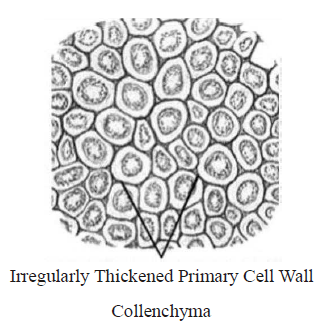
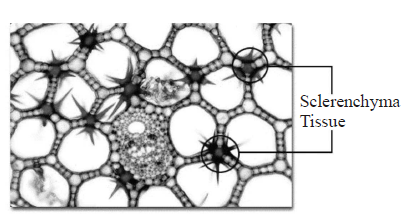
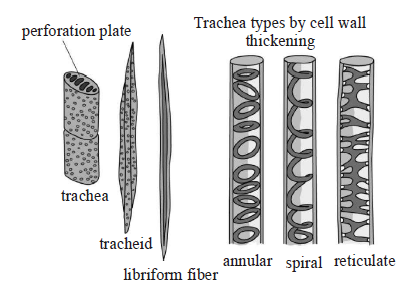
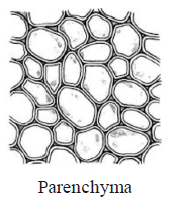
Match the followings and choose the correct option
| Column-I | Column-II |
|---|---|
| A. Cuticle | I. Guard cells |
| B. Bulliform cells | II. Outer layer |
| C. Stomata | III. Waxy layer |
| D. Epidermis | IV. Empty colourless cell |
A III, B IV, C I, D II
A I, B II, C III, D IV
A III, B II, C IV, D I
A III, B II, C I, D IV
The given figure shows the secondary growth in a dicot stem. Their parts are marked as A, B, C, D, E & F. Choose the correct labelling of the parts marked as A to F.

A Phellem, B Phellogen, C Medullary rays, D Secondary xylem, E Secondary phloem, F Cambium ring
A Phellem, B Phellogen, C Medullary rays, D Secondary phloem, E Secondary xylem, F Cambium ring
A Phellogen, B Phellem, C Medullary rays, D Secondary xylem, E Secondary phloem, F Cambium ring
A Phellem, B Phellogen, C Cambium ring, D Secondary xylem, E Secondary phloem, F Medullary rays
A vascular bundle in which the protoxylem is pointing to the periphery is called __________.
endarch
exarch
radial
closed
Which one of the following option shows the correct labelling of the parts marked as A, B, C and D in the given figure of a typical dicot root?
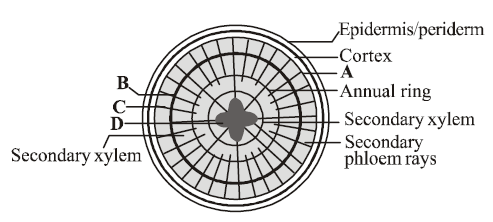
A Primary phloem, B Vascular cambium, C Secondary phloem, D Primary xylem
A Secondary phloem, B Vascular cambium, C Primary phloem, D Primary xylem
A Primary phloem, B Primary xylem, C Secondary phloem, D Vascular cambium
A Secondary phloem, B Primary xylem, C Primary phloem, D Vascular cambium
During the formation of leaves and elongation of stem, some cells left behind from the shoot apical meristem, constitute the
lateral meristem
axillary bud
cork cambium
fascicular cambium
Which of following helps bamboo and grasses to elongate ?
Apical meristems
Lateral meristems
Secondary meristems
Intercalary meristems
Main function of lenticel is
transpiration
guttation
gaseous exchange
both (a) & (c)
Which of the following statement(s) is/are correct ?
- Uneven thickening of cell wall is characteristic of sclerenchyma.
- Periblem forms cortex of the stem and the root.
- Tracheids are the chief water transporting elements in gymnosperms.
- Companion cell is devoid of nucleus at maturity.
- The commercial cork is obtained from Quercus suber.
(i) and (iv) only
(ii) and (v) only
(iii) and (iv) only
(ii), (iii) and (v) only
Which one of the followings option shows the correct labelling of the parts marked as A, B, C and D in the given figure a lenticel?
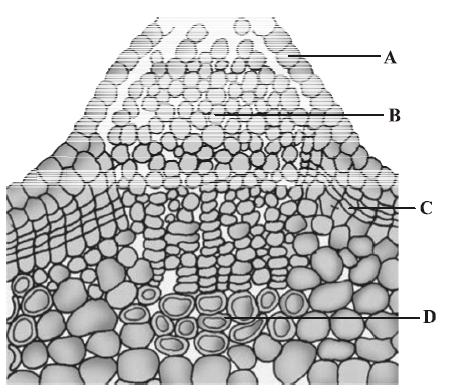
A Epidermis, B Secondary cortex, C Cork cambium, D Cork
A Pore, B Cork cambium, C Secondary cortex, D Cork
A Pore, B Cork, C Complimentary cells, D Cork cambium
A Epidermis, B Complimentary cells, C Cork cambium, D Secondary cortex
Which of the following statements is correct?
Lenticels occur in most woody trees.
Sclerenchymatous cells are usually present in cortex.
The vascular tissue system is divided into three main zones- cortex, pericycle and pith.
The conjoint vascular bundles usually have the xylem located only on the outer side of the phloem.
The given diagrams show stomatal apparatus in dicots and monocots. Which one is correct option for A, B and C?

A Epidermal cells; B Subsidiary cells; C chloroplast
A Guard cells; B Subsidiary cells; C Stomatal pore
A Guard cells; B Epidermal cells; C Guard cells
A Epidermal cells; B Subsidiary cells; C Guard cells
Identify types of vascular bundles in given figures A, B and C.
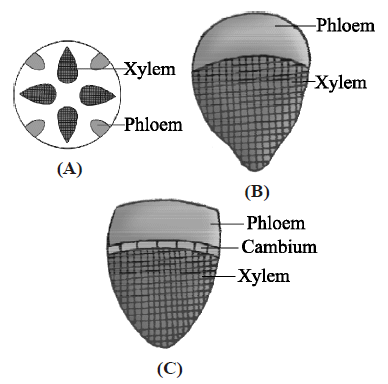
Radial; Conjoint closed; Conjoint open
Conjoint closed; Conjoint open; Radial
Conjoint open; Conjoint closed; Radial
Bicollateral; Concentric; Radial
Xylem functions as a conducting tissue for water and minerals from _________to the ______and__________.
roots, stems, leaves
stems, roots, leaves
leaves, stems, roots
leaves, stems, leaves
Match the elements of xylem given in column I with their character given in the column II and choose the correct option.
| Column-I | Column-II |
|---|---|
| A. Xylem vessels | I. Store food materials |
| B. Xylem tracheids | II. Obliterated lumen |
| C. Xylem fibres | III. Perforated plates |
| D. Xylem parenchyma | IV. Chisel-like ends |
A IV; B III; C II; D I
A III; B II; C I; D IV
A II; B I; C IV; D III
A III; B IV; C II; D I
